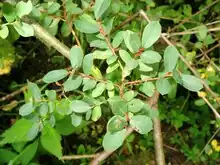| Salix caesia | |
|---|---|
 | |
| Scientific classification | |
| Kingdom: | Plantae |
| Clade: | Tracheophytes |
| Clade: | Angiosperms |
| Clade: | Eudicots |
| Clade: | Rosids |
| Order: | Malpighiales |
| Family: | Salicaceae |
| Genus: | Salix |
| Species: | S. caesia |
| Binomial name | |
| Salix caesia | |
Salix caesia is a small shrub in the genus Salix, the willows. It is widespread, mainly in Asia.
Taxonomy
The name Salix caesia was first published in 1789 by Dominique Villars.[1] Synonyms for Salix caesia are: Salix minutiflora Turczaninow ex ELWolf, Salix divergens Andersson, and Salix myricaefolia Andersson.[2][3]
Description
Salix caesia is a densely branched dwarf shrub that reaches heights of up to 70 cm (28 in). The bark of young twigs is reddish-brown or reddish-black and sometimes silky hairy; later the bark of the branches is bare, brown and shiny.[2][3]
The leaves are simple, alternate, and glabrous, with a petiole 1 to 3 mm (0.039 to 0.12 in) long. The blade is 0.5 to 3 cm (0.20 to 1.18 in) long and 0.3 to 1 cm (0.12 to 0.39 in) wide, elliptical to obovate, with a pointed (rarely blunt) tip and a wedge-shaped base. They are dark green on the upper surfaces and blueish green on the undersides. The leaf margin is nearly smooth. The stipules are usually small.
The flowering period begins in May. The catkins are elongated with a length of 1 to 2 cm (0.39 to 0.79 in). The bracts are light brown, weak, and hairy. The male flowers contain two stamens, partially fused, and the anthers are dark blue-violet. In female flowers, the ovary is almost sessile, hairy, the style relatively short and thick, the stigmas red and not divided, and they have a nectar gland.[2][3]
The yellowish to brown, hairy, two-lobed capsule fruits are 4 to 5 mm (0.16 to 0.20 in) long. The seeds are surrounded by fine hairs.[2][3]
The number of chromosomes is 2n=76.[4]
Distribution and habitat
The main distribution areas of Salix caesia are the Chinese autonomous regions of Xinjiang and Tibet; Central Asia: Afghanistan, Kyrgyzstan, Tajikistan, Mongolia; West and East Siberia, Pakistan and Kashmir.[2][3] It is very rare in Europe, where it has been found in Italy, France, Switzerland, and Austria.
It grows in subalpine meadows and thickets. It is a characteristic species of German "Salicetum Caesio-foetidae" from the association "Salicion waldsteinianae".[4]
References
- ↑ "Salix caesia Vill". Tropicos.
- 1 2 3 4 5 Cheng-fu Fang, Shi-dong Zhao, Alexei K. Skvortsov: Salix. Salix caesia, S. 262 – textgleich online wie gedrucktes Werk, In: Wu Zheng-yi, Peter H. Raven (Hrsg.): Flora of China. Volume 4: Cycadaceae through Fagaceae, Science Press und Missouri Botanical Garden Press, Beijing und St. Louis 1999, ISBN 0-915279-70-3.
- 1 2 3 4 5 Beschreibung in der Flora of Pakistan.
- 1 2 Erich Oberdorfer: Pflanzensoziologische Exkursionsflora für Deutschland und angrenzende Gebiete. 8. Auflage. Verlag Eugen Ulmer, Stuttgart 2001, ISBN 3-8001-3131-5, S. 309.
Andreas Roloff, Andreas Bärtels: Flora of the woods. Purpose, properties and use. With a winter key from Bernd Schulz. 3rd, corrected edition. Eugen Ulmer, Stuttgart (Hohenheim) 2008, ISBN 978-3-8001-5614-6.
- Salix caesia Vill., Blaugrüne Weide. In: FloraWeb.de.
- Salix caesia Vill. In: Info Flora, the national database and information centre of Swiss flora. retrieved 3 October 2015.
- Thomas Meyer: Datenblatt mit Bestimmungsschlüssel und Fotos bei Flora-de: Flora von Deutschland (alter Name der Webseite: Blumen in Schwaben).
- Michael Hassler, Bernd Schmitt: Datenblatt bei Flora von Deutschland – Eine Bilder-Datenbank, Version 2.92.